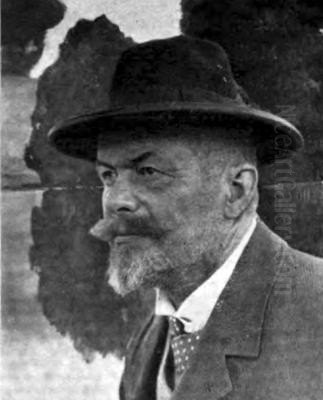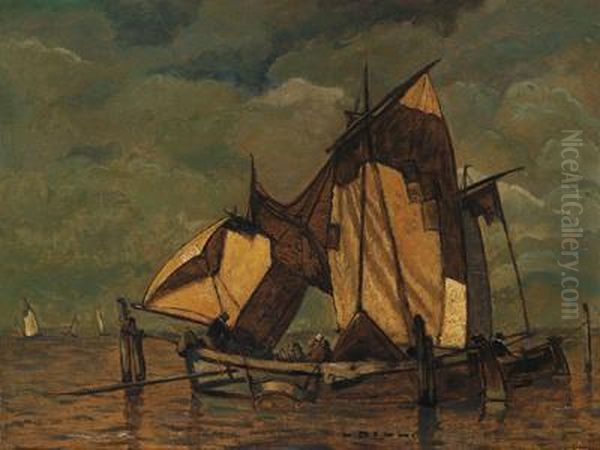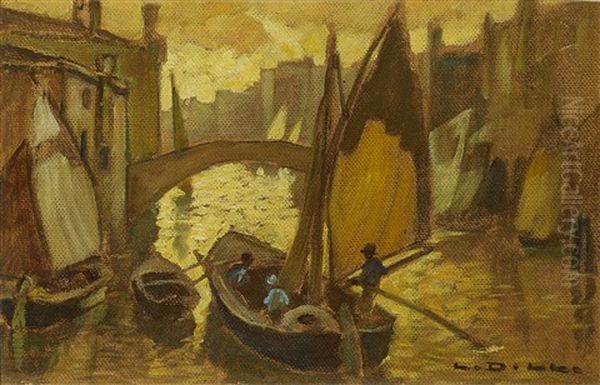Introduction: A German Artist of Transition

Ludwig Dill (1848-1940) stands as a significant figure in German art history, particularly noted for his contributions to landscape painting during a period of significant stylistic transition. Born in Gernsbach, Baden, Dill's long career spanned the late 19th and early 20th centuries, witnessing the shift from academic traditions towards modernism. He was a German national whose work is primarily associated with Impressionism and the elegant lines of Art Nouveau, known in Germany as Jugendstil. Dill distinguished himself not only through his evocative paintings, often created outdoors (en plein air), but also as a key organizer and leader within the progressive art movements of his time, most notably as a co-founder and president of the Munich Secession and a central figure in the Dachau artists' colony.
Early Life and Unconventional Path to Painting
Ludwig Dill's journey into the world of art was not a direct one. He initially pursued a more practical path, completing studies in engineering, although he reportedly did not receive official certification. Following this, he served as a soldier. His aspirations then turned towards architecture, and he began studies in Stuttgart. However, his trajectory took a decisive turn thanks to the insight of his architecture professor, Adolf Gnauth. Upon reviewing Dill's portfolio, Gnauth recognized a different calling for his student, famously advising him, "You absolutely must become a painter." This pivotal moment redirected Dill towards the fine arts, setting him on the course that would define his life and legacy. He subsequently enrolled at the Academy of Fine Arts in Munich, immersing himself in the city's vibrant artistic environment.
The Munich Secession: A Break with Tradition
The late 19th century in Munich was a time of artistic ferment. The established art institutions, particularly the conservative Munich Artists' Cooperative (Münchner Künstlergenossenschaft) and its official exhibitions at the Glaspalast, were increasingly seen by younger, more progressive artists as stifling and resistant to new styles like Impressionism and Symbolism. In response, a group of artists broke away in 1892 to form the Munich Secession (Münchner Secession). Ludwig Dill was not merely a participant but a driving force behind this movement, serving as one of its founding members.

The Secession aimed to create an alternative exhibition platform, promoting higher quality, greater stylistic diversity, and a more international outlook, free from the constraints of the traditional jury system. Dill's leadership qualities were recognized by his peers, and he served as the President of the Munich Secession from 1894 to 1899. During his tenure, the Secession established itself as a major force in the German art world, showcasing works by leading avant-garde artists from Germany and abroad. Fellow members and contemporaries associated with the Secession included prominent figures like Fritz von Uhde, Franz von Stuck, Wilhelm Trübner, Lovis Corinth, Max Slevogt, and Hugo von Habermann, representing a spectrum of modern styles emerging at the time. While Max Liebermann was more central to the Berlin Secession, his Impressionist work was certainly part of the broader context of artistic renewal Dill championed in Munich.
Dachau: Landscape, Community, and Rural Naturalism
Seeking inspiring landscapes and perhaps a respite from the urban center, many Munich artists were drawn to the nearby town of Dachau. Situated amidst picturesque moorlands (the Dachauer Moos), marshes, and birch groves under expansive skies, Dachau offered ideal motifs for landscape painters interested in capturing atmospheric effects and the rustic charm of rural life. It developed into a significant artists' colony by the late 19th century.
Ludwig Dill became deeply connected with Dachau. He spent numerous summers painting in the area, captivated by its unique natural beauty. In 1899, he solidified his connection by purchasing property there. His work from this period often focused on the distinctive local scenery – the flat, waterlogged moors, the reflective surfaces of canals and ponds, and the slender forms of birch trees, often rendered with a sensitivity to light and atmosphere that reflects Impressionist influences. Some sources describe his style during this phase, particularly his depictions of the local environment and its inhabitants, as a form of "Rural Naturalism," suggesting a focus on authentic, unidealized portrayals of country life, though often imbued with a lyrical or decorative quality.
Neu-Dachau: Collaboration and Stylistic Synthesis
Dill's engagement with Dachau extended beyond his individual artistic practice. He formed close associations with fellow artists Adolf Hölzel (1853-1934) and Arthur Langhammer (1854-1901). Hölzel, in particular, was an influential painter and art theorist who ran an art school in Dachau. Together, Dill, Hölzel, and Langhammer became the core figures of a group or tendency known as "Neu-Dachau" (New Dachau).

This collaboration was formalized through the founding of the "New Dachau" art school, further cementing the town's reputation as an artistic hub. The artists associated with Neu-Dachau sought to move beyond straightforward naturalism, developing a more stylized approach to landscape painting. They emphasized simplification of form, strong compositional structures, and the expressive potential of color and line, often creating highly decorative interpretations of the Dachau landscape. Their style represented a synthesis, blending the Impressionists' focus on light and fleeting moments with the ornamental and linear qualities characteristic of Jugendstil. This collaborative spirit and shared aesthetic vision marked a distinct phase in the Dachau colony's development. While not directly part of Neu-Dachau, the broader Jugendstil movement included influential figures like Peter Behrens and Otto Eckmann, whose work shared an emphasis on decorative form.
Artistic Style: Impressionism Meets Jugendstil
Ludwig Dill's mature artistic style is best characterized by its fusion of Impressionist techniques with Jugendstil sensibilities. As a dedicated landscape painter and an advocate of plein air painting, he frequently worked outdoors, directly observing nature in locations like the Dachau moors and the lagoons of Venice, another favorite sketching ground. His work reflects the Impressionist concern with capturing the transient effects of light and atmosphere. This is evident in his often bright palette, his use of broken brushwork, and his focus on reflections in water. He absorbed lessons from French Impressionists like Claude Monet and Camille Pissarro regarding the depiction of light and color.
However, Dill did not simply replicate Impressionism. He integrated these techniques into a style that increasingly emphasized decorative qualities, aligning him with the burgeoning Jugendstil movement. This is apparent in his tendency towards flattened perspectives, simplified shapes, strong silhouettes, and rhythmic, flowing lines, particularly in his treatment of trees, water, and clouds. His compositions often possess a strong sense of design, transforming natural scenes into carefully orchestrated arrangements of color and form. This decorative impulse distinguishes his work from both purely academic painting and mainstream Impressionism, giving it a unique place within German art at the turn of the century.
Representative Works: Capturing the Moors
Among Ludwig Dill's most characteristic and celebrated works are his depictions of the Dachau moorlands. Two notable examples, both held by the Dr. Ulrich and Gertrude Lechner Foundation and housed in the Dachau Museum (Gemäldegalerie Dachau), are:
Das weiße Moor (The White Moor), 1900: This painting (70 x 87 cm) likely exemplifies Dill's engagement with the unique atmosphere of the Dachauer Moos. The title suggests a focus on the particular light conditions or perhaps the colors of the moorland vegetation at a certain time of year. One can anticipate a composition that balances naturalistic observation with the stylized, decorative approach characteristic of his Neu-Dachau period, perhaps emphasizing horizontal lines and reflective water surfaces under a vast sky.

Im weißen Moor (In the White Moor), 1915: Created fifteen years later, this work revisits the moorland theme. The title, translating to "In the White Moor," might imply a more immersive perspective or perhaps feature figures within the landscape, exploring the relationship between humanity and this specific natural environment. Given the later date, it might show further evolution in his style, potentially incorporating bolder colors or more abstract tendencies, while still retaining the core elements of his landscape vision developed in Dachau.
Another work mentioned is Infanterie (1915), a smaller piece (19 x 27.5 cm) noted as being held in Karlsruhe. The title suggests a military theme, perhaps reflecting the period of World War I. This indicates a broader range of subject matter beyond pure landscape, although landscape elements might still feature.
These works, particularly the moorland scenes, encapsulate Dill's ability to convey the specific mood and visual character of a landscape through his distinctive blend of Impressionistic light and Jugendstil design.
Later Life, Teaching, and Legacy
Ludwig Dill remained an active figure in the art world throughout his later years. He held a teaching position at the Academy of Fine Arts in Karlsruhe, sharing his knowledge and experience with a new generation of artists. His personal life saw changes; his first wife passed away in 1905, and four years later, in 1909, he married the painter Johanna Malburg.
His connection to Dachau remained strong. He continued to spend considerable time there until 1919. His contributions to the town's artistic life and reputation were formally recognized in 1936 when he was made an Honorary Citizen of Dachau. Beyond his painting and teaching, Dill also engaged in applied arts, serving on a design committee for the Stollwerck chocolate company, a common practice for Jugendstil artists who sought to integrate art into everyday life.
While the provided sources mention an interest in the music of Richard Wagner and Giuseppe Verdi, there is no evidence of direct collaboration or interaction with these composers; it likely reflects his broader cultural interests. His work did find resonance in literary circles; the poet Rainer Maria Rilke reportedly mentioned his art, and the Bavarian writer Ludwig Thoma incorporated Dill's landscapes into his work Agricola.
Ludwig Dill passed away in Karlsruhe in 1940 at the age of 91. His legacy lies in his significant body of landscape work, his influential role within the Munich Secession and the Dachau artists' colony, and his successful synthesis of Impressionist and Jugendstil elements, creating a distinctive and decorative vision of nature.
Collections and Market Presence
Works by Ludwig Dill are held in public collections, ensuring their accessibility for study and appreciation. As noted, the Dachau Museum (Gemäldegalerie Dachau), through the Dr. Ulrich and Gertrude Lechner Foundation, holds key works like Das weiße Moor (1900) and Im weißen Moor (1915). The mention of Infanterie (1915) being in Karlsruhe suggests its presence in the collection of the Staatliche Kunsthalle Karlsruhe or another institution in the city.
Dill's paintings also appear on the art market. Auction records indicate the circulation of his works, providing insights into their valuation and desirability among collectors. Examples of works offered at auction include:
Segelboot mit zwei Personen (Sailboat with Two People), an oil painting (18.2 x 20.8 cm) with an estimate of €300-€450.
Fischerboote in der Lagune (Fishing Boats in the Lagoon), a mixed media work (21 x 36.3 cm) estimated at €800-€900, likely reflecting his time in Venice.
Segelboot in Chioggia (Sailboat in Chioggia), another Venetian-themed oil painting (20.8 x 32.7 cm), estimated at €800-€1,000.
Kinder im Garten (Children in the Garden), a larger oil painting (81.5 x 61 cm) with an estimate of €1,200-€1,800.
While these examples demonstrate his market presence, it's worth noting that the provided source material did not contain specific auction records for the major works Das weiße Moor or Infanterie. The varying estimates reflect differences in size, medium, subject matter, and condition typical of the art market.
Conclusion: An Enduring Influence
Ludwig Dill occupies an important position in the narrative of German art around 1900. He was more than just a skilled landscape painter; he was an active participant and leader in the movements that sought to modernize German art. As a founder and president of the Munich Secession, he helped challenge the dominance of academic conservatism. In Dachau, he not only captured the unique beauty of the moorlands but also collaborated with Hölzel and Langhammer to forge the distinctive "Neu-Dachau" style, contributing significantly to the identity of the artists' colony.
His artistic output skillfully navigated the currents of Impressionism and Jugendstil, resulting in works that are both sensitive observations of nature and elegant decorative compositions. Through his long career as an artist, teacher, and organizer, Ludwig Dill left an indelible mark on the artistic landscape of southern Germany, bridging the traditions of the 19th century with the emerging aesthetics of the 20th. His paintings continue to be appreciated for their atmospheric charm and stylistic ingenuity.